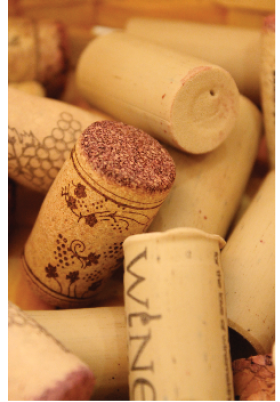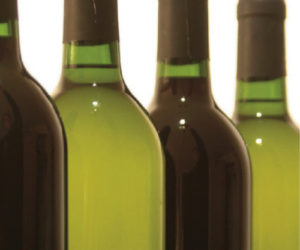
Nothing has been overlooked in producing the bottle you now are proudly uncorking as your guests wait expectantly. The “pop,” the flourish … and you pour yourself a tiny sample, just to gloat a little before sharing.
Aargh! The aroma of aged sweat socks assaults your nostrils and you quickly return to the cellar for a different bottle. “What happened?” you fume.
Winemaking is an exacting art that demands one really sweat the details. Nonetheless, there can be an all-too-human tendency to overlook one or another apparently minor aspect of the process.
Such an item is the closure used on the bottle, be it the traditional cork or some new-wave hybrid. While we tend to consider this a minor part of the winemaking picture, it is in fact the last thing we can influence before the wine is put down for aging. Since it remains in contact with the wine, or at least seals it from the oxygen that can cause spoilage, it is vital that the closure be correctly selected and properly prepared.
The average home winemaker, visiting a local supplier or surfing the Internet to find a mail-order company, will be presented with a range of closure possibilities. These can include traditional wooden corks of various qualities, shapes and methods of production; synthetic cork imitations; hybrids of plastic and cork; screw caps and more. Choosing the best one — or the one that will suit the task adequately — need not be difficult. But it does require familiarity with the role of the closure and how it affects the wine.
Let’s take a look at the various types of bottle closures. While new prototypes appear frequently, there are several broad categories to choose from, based both on function and the aesthetics of making your bottle look, seal and age just the way you intended. (Unless, of course, you like the smell of aged sweat socks)!
Natural Corks:
Oak Bark from Spain and Portugal
A cork by any other name . . . would be a damp piece of wood. However, as fate would have it, there is a specific type of wood, the cork oak (Quercus suber), which has very unique properties that have made corks the bottle closure of choice apparently since bottles were invented. Grown mainly in Mediterranean countries (Spain and Portugal together account for 70 percent of the world’s production), this oak species possesses the capability of having its dead outer bark stripped away from the inner, living section every nine years or so, with no harm to the living tree.
The outer bark has a number of special qualities that make it an ideal bottle closure. Its molecular structure makes it largely hollow, akin to foam rubber, and this renders it highly compressible while remaining fairly solid in terms of its outward physical characteristics. It holds up well when in contact with liquids, and is fairly easily worked into shapes. Last, the flavor and tannins of the cork can add a few subtle complexities to a wine as it ages, although not in a major way.
According to famed French enologist Emile Peynaud, 85 percent of a cork’s volume consists of oxygen and nitrogen gas that fill the hexagonal cells of the cork itself. This helps the cork to be easily compressed, yet return to its starting size quickly and easily, regaining 4/5 of its diameter almost instantly and recovering fully within 24 hours. This process is dependent on the moisture content of the cork; a more moist cork (say, six to eight percent water) is far more elastic than a dry one. Cork also does not slide easily, having a high friction coefficient, and thus adheres well to the sides of a bottle. It is nearly impermeable to liquids, absorbing them very slowly. Also, there may be a slow and subtle “breathing” that helps the wine age, although this is not agreed upon by all authorities, some maintaining that oxygen taken up at bottling is what causes bottle aging.
If, as Peynaud says (in his classic book Knowing and Making Wine), “Even today cork has maintained its superiority and its prestige and constitutes the only method of closure capable of ensuring long-term storage of quality wines,” then why are there so many other options for closure available today? One answer lies in the popularity of corks and ever-growing demand for them, and the resulting variable quality of some corks on the market. This has resulted in problems getting each cork to live up to Peynaud’s glowing description (which of course was only intended to apply to sound, properly prepared, high-quality cork).
To understand how each cork cannot be all that the ideal cork can be, it is useful to look at the way corks are manufactured. Obviously, nice cylindrical #9 “extra firsts” are not plucked whole from the limbs of the cork oak, but must be refined from the raw material stripped from this renewable resource.
Cork goes through several purification steps. After removal from the tree, it is aged until properly seasoned for manufacturing, sliced into sheets, boiled to eliminate insects and microorganisms, then punched into rough cork shapes. The rough corks are then put through a series of washes for further purification. Traditionally this was done with a chlorine bath, followed by oxalic acid, then a rinse with clean water. The corks are then dried to a uniform moisture level, polished into their final shape and packaged, usually in plastic bags sanitized with sulfite gas.
Haphazard rinsing was probably the main source of problems with “corkiness,” the musty off-aroma mentioned above. Residual chlorine formed TCA (2-4-6 tricholoranisole), which produces a corky reek that spoils wine. For some years in the past few decades, this problem became acute as lower grades of cork, which were more porous and harder to rinse thoroughly, were pressed into use owing to greater demand as wine sales expanded. As a former executive of a cork-importing company told me, the problem led to a significant increase in the price of top corks, as limited supply met increased demand from top estate wineries.Today, the corkiness problem has been reduced to a low percentage of corks sold for wine closures (one to three percent, frequently), owing to stricter selection of raw cork, improved machinery for washing and rinsing (including a tumble washer), greater quality control by the cork manufacturers, and the development of non-chlorine washing systems (such as peroxide and sulfur dioxide). While whole conferences of enologists have been devoted to the problem, suffice it to say that corks of the better grades (super, extra first and first) are once again very reliable as bottle closures. The incidence of corkiness is very low, and some winemakers may never encounter it if they use good-quality corks.
Unfortunately, continued demand for corks has meant that, in general, corks are simply not as high in quality as they once were. What used to be “grade two” might now be called “extra first” by some suppliers. Good corks are still fine closures, but frequently the best lots are reserved for commercial wineries, or are so expensive that home winemakers are reluctant to buy them. As John Pastor of The Grape and Granary, an Akron, Ohio supply business, stated, “The quality of natural cork continues to decline. Many customers are shocked to see the price of a decent natural cork.” (Top-quality corks can cost as much as $10 for a bag of 25, or even more.) The problem is less with TCA contamination today than price and the tendency of some lower-grade corks to occasionally leak.
One thing to be careful about when buying corks from a supply shop is to make sure the corks are “fresh,” in other words, that they have not been sitting in a bin for months, drying out and providing a nesting place for all of the microorganisms that are floating about. As Fred Czuba of F.H. Steinbart, an Oregon wholesaler, notes, if the shop turns their stock frequently, there should not be a problem. Corks that live on a shelf too long will be dry, brittle, hard to insert and may have spoilage organisms living in them. Once the bag is opened from the manufacturer, the corks begin to be compromised, so reputable dealers will take steps to minimize this potential problem.
The standard size for most wine bottles is #9, which translates to a diameter of about 15/16 of an inch. Length is normally 1-3/4 inch, although 1-1/2 inch is also used, especially for half-bottles or wines not destined for long storage. “Chateau” type corks can run 2 to 2-1/2 inches long, but are not needed for most wines. Some winemakers save a little money by using narrower-diameter #8 or even #7 corks, but these obviously do not re-expand to form as tight a seal as #9 corks do. Still, if you have an inexpensive corker, #8 corks are easier to get into the bottle. Obviously, the choice is up to the individual.In the period when quality was even more variable, cork producers and closure companies began developing non-cork alternatives, as well as other forms of cork that could be rendered less risky through processing. These are also available to the home winemaker, although it is unlikely they will completely replace the classic cork, which generally performs its function well and has the weight of tradition and aesthetics on its side.
Manufactured Corks:
Ground, Glued, Sandwiched
Since it has become harder for both wineries and home winemakers to easily obtain good quality corks, manufacturers have developed ways of enhancing the sealing properties of lower grades of cork, in effect “improving” them to higher grades. There are many types of these “agglomerated” corks. These include ground cork particles held together with adhesive, which one encounters in less expensive imported wines. Closures of this type will cost about $4 for 25.
A similar cork — but a step up in quality — is the colmated cork, in which a fairly porous natural cork is coated with an adhesive and then filled and sealed with cork dust in a tumbler.
The result is a very reliable cork that is widely sold in supply shops (Grape and Granary, for example, reports that 80 percent of closure sales are colmated corks). A rough price for 25 colmated #9 corks is about $5 from many shops.
A second type of manufactured cork is the sandwich variety. In this category, lower-grade or composition cork is used for the center of the cylinder, and slices of top-grade cork are used on the ends to seal better and still provide the organoleptic qualities of real cork. Fred Czuba of F.H. Steinbart feels that these corks are reasonable alternatives for those who want to use solid cork rather than agglomerated or colmated corks, but do not want to pay 50 cents each or more for “chateau” grade corks.
A third type of these closures is a sort of “package,” in which lower-grade corks are sterilized and filled, then sealed with an outer plastic membrane. One brand name is Steriseal II, and Presque Isle Wine Cellars of North East, Pennsylvania reports good results with them. These can be a little harder to insert with small hand corkers.
Synthetic Corks:
The Plastic Alternative
In the past few years, more and more commercial wines have begun to appear with wildly-colored plastic “corks,” which often form part of the marketing package of the wine itself. After lead foil capsules were banned, some wineries found that a colored closure that complemented the label made an economical and eye-catching substitute. In addition, the synthetic corks cost less than traditional wooden ones, and were almost completely unlikely to have any TCA taint problems. (It is interesting to note that there still was the occasional “corked” bottle, but this seems to be due to the use of chlorine-based cleaners, which are best avoided around wine).
A wide variety of plastic closures are available, and technological improvement has made many of these far easier to work with than early models — which tended to be very hard to insert without a commercial corker, hard to remove from the bottle, and all but impossible to reinsert. Such brands as Nomacorc and Guardian are surprisingly similar to wooden corks when it comes to handling, and claims are made for superior sealing capabilities and reliability. “More and more customers are moving to polymer corks because of their value,” says John Pastor. “They are functionally superior to natural corks in the same price range.” It is worth pointing out that synthetic polymers may be harder to compress, making a heavy-duty corking device necessary, or at least desirable.
Another factor in the rise of synthetics is whether the wine really needs to have an expensive cork closure intended to carry it for decades of bottle age. Since most wines are consumed within a few years of their birth, and a few hours after purchase, they probably gain little or nothing from the use of a natural cork. As one pundit put it, “The purists hate them, but let’s face it, it doesn’t quite make sense to use cork in bottles that are opened the same day, or a week after purchase.” One might add, or bottles that are opened within a year or two of bottling.
A final category of hybrid closure is a combination of some natural cork and some synthetic material, in hopes of combining the aging (or “breathing”) and organoleptic aspects of wooden cork with the reliability, sealing and cleanliness of polymer closures. One example is the Altec brand. Claims are made for this closure’s ease of extraction and its function in wine aging akin to natural cork (for example, by www.ebrew.com, a mail-order supply shop based in North Carolina).
If a closure can be developed which is relatively inexpensive, has the aging capabilities of cork, and the foolproof nature of synthetics, it is conceivable that Peynaud’s statement about natural corks may need some adjusting in the future. It seems the future may be approaching faster than one thought, which may explain the concern expressed by Portuguese cork farmers in an Associated Press article that their livelihood may be threatened by the rise of synthetic and hybrid closures, even though some thirteen billion closures a year are sold worldwide.
In passing, one should also note that tapered corks, “T” corks, screwtop and even crown-capped closures can be used for wine, particularly if the wine will be consumed within a year or so. Dipping the bottle necks in paraffin or wax will help these closures seal more effectively as well. Other alternatives: Oxygen-barrier caps, used primarily for beers entered in competitions or beers that will be aged a long time. Resealable flip-top “Grölsch” beer bottles also work, but the rubber gasket could harm the flavor of the wine over time.
So what closure is right for your wine? The answer is a combination of price, ease of usage, how long you want to cellar the wine, availability, and, of course, what you as the winemaker find most satisfying aesthetically. Not all wines may require the finest of natural corks, but you may find that nothing else will satisfy — especially when opening your best for your friends. On the other hand, you may think that new hot-pink synthetic cork makes a design statement for your blush wine that’s too enticing to pass up. The fun of this hobby lies in the freedom of expression each winemaker can bring to their cellars, bottle by bottle and cork by cork.




